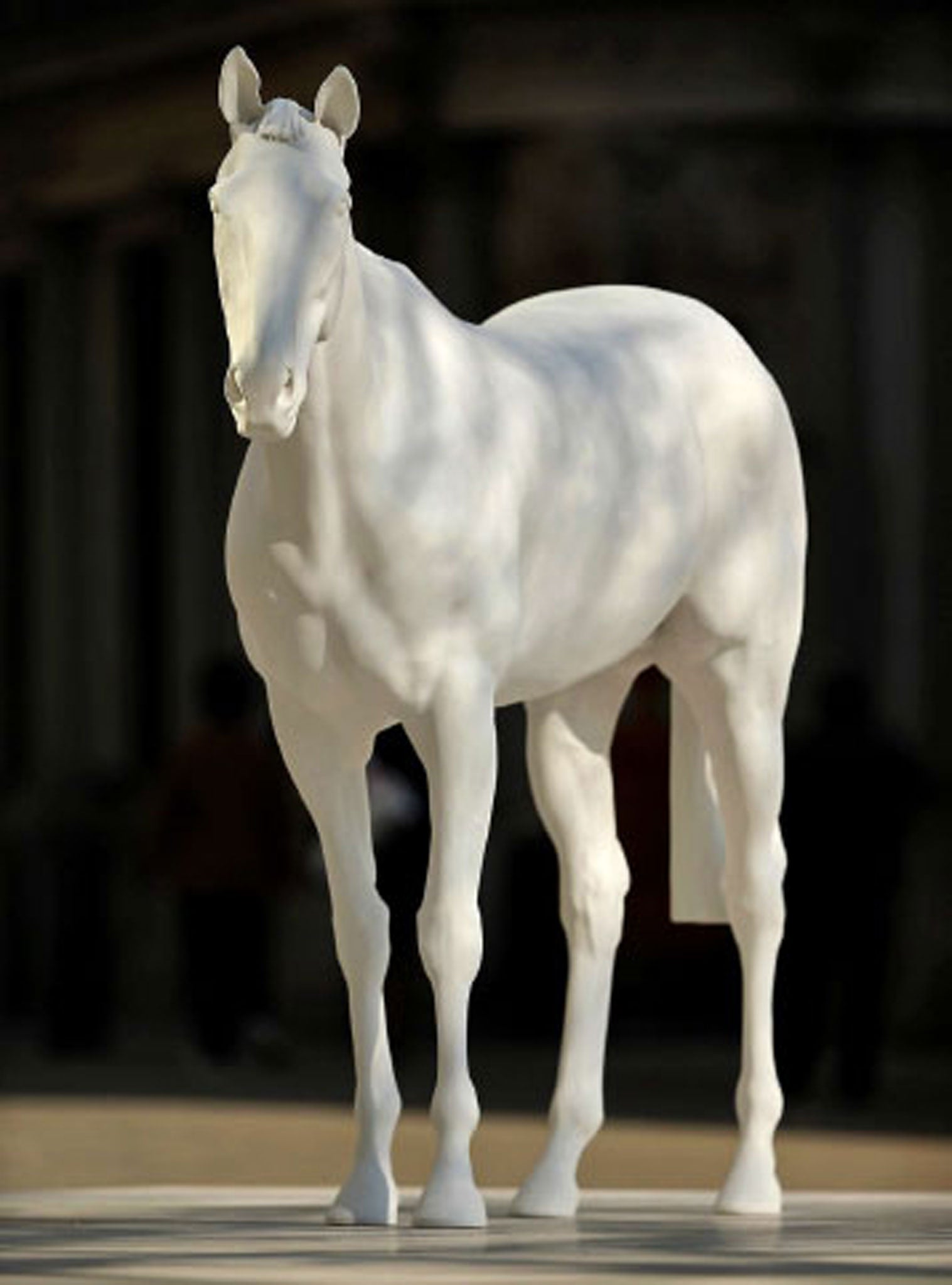Great Works: The White Horse (2013) Life-size by Mark Wallinger
Spring Gardens, London

Are you aware that the piazza in front of the British Council's Spring Garden headquarters at the eastern end of the Mall is a temporary exhibition space for public art? It currently displays Mark Wallinger's White Horse, a life-size reproduction of a race horse in marble and resin that stands close to one corner of a large, low, rectangular plinth.
The centre of London rampages with equestrian portrait sculptures of a fairly traditional stamp, from Field Marshal Earl Haig in Whitehall to that great pudding of Edward VII, Rex et Imperator, in Waterloo Place. In any equestrian statue, the horse exists to exalt or to set off the man who is its mount. We are also being persuaded that something of the power and the musculature of the horse itself seeps into the very veins of the man, apportioning him some of its animal strength and vigour.
Wallinger's horse feels both related and unrelated to all these equestrian manifestations in a number of interesting ways. It is unmounted for a start, and it is nothing but horse without tackle, wholly unencumbered. It is not there to be seen in relation to the one who subjugates it or shows himself off at its expense. It does not exist to point a tale, martial or monarchical. Being quite shockingly white – especially when the sun blazes out – it puts us in mind of England's bevy of white horses out in the landscape, those strange apparitions in white silhouette that exist on our chalky, gently rising hillsides as we shift towards the West, and whose symbolic importance we often find ourselves musing upon as we rush by them in train or car.
Wallinger's nag is not in frisky or combative mood. Quite the opposite, in fact. It looks positively self-absorbed in its graceful serenity, almost mystically self-contained. Its front legs seem inclined to move, but its back legs hold a different point of view. Almost most interesting of all, it is not perfectly centred on its very large and low-lying white plinth. In fact, it stands towards one corner, as if it has been set free to roam, and has reached a certain decision as to its own positioning. The head is slightly canted down to the left.
Public art is art that exists in a public context, and it is constantly modified by that context. And so it is here. This horse causes us to reflect upon all the other horses, man-made and real, which circulate about central London.
The presence of the horse on this plinth – it could be the horse's own browsing space – causes us not only to think about the meaning of the supportive role that horses tend to play horses in equestrian portrait sculpture, but it also reminds us that a low line of view brings us much closer to what we are looking at, both physically and emotionally. It grounds the object. It makes the onlooker feel on a level with it. We are no longer set apart from it. We achieve a kind of casual intimacy with this preternaturally white horse – various people are stepping up on to its plinth to get a better view of it as I stand looking at it. In short, the plinth has increased its approachability.
What is more, those other equestrian statues nearby feel strangely compromised and exposed by the presence of this white horse in their midst. It seems to be showing them up for what they are, mere props for man's self-aggrandisement and myth-making. The only horse it seems to crave kinship with is that golden rocking horse on the fourth plinth in Trafalgar Square, just a couple of hundred yards away from here, which is also cocking a snook at the silly posturings of monarchs and warmongers.
As Jonathan Swift pointed out in his wonderful parable of the Houyhnhnms and the Yahoos at the tail end of Gulliver's Travels almost three hundred years ago, horses are so much less base than human beings.
About the artist: Mark Wallinger
The English painter, sculptor and video artist Mark Wallinger was born in Chigwell, Essex, in 1959. He studied at the Chelsea School of Art and Goldsmiths College, both in London. Horses and horse-racing have long been a passion, which eventually culminated in the purchase of his own race horse, a two-year-old filly, in 1994, which he called A Real Work of Art. He was short-listed for the Turner Prize in 1995 for A Real Work of Art, a model of his horse.
Subscribe to Independent Premium to bookmark this article
Want to bookmark your favourite articles and stories to read or reference later? Start your Independent Premium subscription today.

Join our commenting forum
Join thought-provoking conversations, follow other Independent readers and see their replies